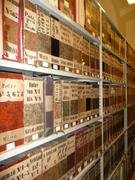RISM in the Classroom at the University of Vienna
Ikarus Kaiser
Wednesday, April 25, 2012

At the University of Vienna, Ikarus Kaiser taught the first course that focused on working with the RISM database. Ten musicology students attended.
Thanks to the outstanding cooperation of Martin Czernin, the leader of the Schottenstift Archive (Scottish Abbey) in Vienna, nine class sessions were held in the archive from November 2011 to January 2012, following an introductory phase in October 2011. The course was designed for the specific research opportunities afforded by the music manuscripts in this archive (RISM library siglum: A-Ws). The goal was to learn and work with the Kallisto program, which is used worldwide to enter records into the RISM database. The RISM Zentralredaktion set up collective access for the course, through which the participants could directly and simultaneously access the database. The students for the most part installed the required Kallisto program on their own laptop computers. One additional computer with Kallisto was available in the abbey archive and one was in the seminar room of the Institute for Musicology. In general, no major technical difficulties occurred; only two students with Apple laptops had to find other means, since Kallisto is configured for Windows systems.
In order to pass the course, students had to fulfill the following requirements:
-
Regular attendance and participation.
-
Enter 30-50 records into the RISM database. The records were continuously monitored. Each student was assigned 50 consecutive RISM numbers (605009…) to independently work with and manage. Through these numbers, it was evident at all times who entered records, how many, on which date, and at which level of quality. The students received index cards with information about the sources already filled outbeforehand, which they could take home and enter into Kallisto. During on-site visits either during class time or on their own, students could consult the archival materials and add to the records.
-
Short presentation on any catalog of works with the purpose of discussing different organizational systems for compositions.
-
For the final examination, the completed records were discussed with each respective student. A manuscript was shown to the student and a new RISM entry had to be created independently. A general question had to be answered, taken from the introductory sessions of the course. (Topics included “Source Studies as a Basic Discipline of Historical Musicology – Heuristics, Source Criticism, Interpretation, Historiography,” “History, Series Organization, Structure, and Current Operation of RISM,” “Archival Requirements,” “Principles of Arrangement for Music Archives and Archival Materials,” “Conservation Measures,” “Knowledge of the Largest Music Collections,” “Research Tools in Music Bibliography,” “Dating Musical Sources,” and “Music Publishers.”)
In the course of the semester, 366 new titles were recorded. Including incipits, a total of 815 records were created. The manuscripts originated from the second half of the 18th century and the 19th century. Works by the following composers were processed: Anonymous (1 title), Engelbert Aigner (1), Johann Georg Albrechtsberger (44), Ignaz Aßmayr (1), Haydn (2), Joseph Haydn (14) Michael Haydn (240), Ferdinand Kauer (1), Georg Reutter fils (62).
Share Tweet EmailCategory: Events

